St. Cuthbert's Hall, Halsall

According to John Cotterall in his book ‘Halsall: The village built on a rock’, St. Cuthbert’s Hall started life as a tithebarn. The word ‘tithe’ means ‘tenth’ so it is fitting that tithes were originally a tax that required one-tenth of all agricultural produce (such as corn, potatoes, milk, eggs, etc.) to be paid annually by the villagers to support the church and clergy. The Tithe Act of 1836 set out the commutation of tithes, replacing the payment of tithes in kind with monetary payments or rent charges depending on the price of grain. Mannex’s Directory of Mid-Lancashire 1854 states that in respect of Halsall, ‘the tithes were commuted and confirmed in 1843 for a rent charge of £3,500, but the benefit is worth nearly £4000’.
In 1861, the scholars from the Grammar School based at St. Cuthbert’s Church were transferred to a new school – the building that came to be known as the ‘Old Schools’ and then St. Cuthbert’s Hall. In any event, the Tithes Act 1936 abolished tithe payments in relation to the church and clergy.
Incidentally, the Grammar School was founded by Edward Halsall in 1593 – 430 years ago! Originally, it was two storeys with the main entrance being the blocked doorway in the east wall which is still visible today. According to Edward Baines in the ‘History of the County Palatine and Duchy of Lancaster, 1836, Volume 4′, 54 boys attended the school and were taught on the ground floor. The girls were taught on the first floor by the Master’s wife.

In the 1841 Census for Halsall, two teachers are listed – Thomas Sumner, 65 years old, and James Mawdsley, 49 years old.
Thomas Sumner was married to Alice and they had a daughter, also called Alice, and a son, Thomas. It is not clear from the 1841 census where Thomas senior was born but he died in Halsall in 1849 and was buried at St. Cuthbert’s Church on 1st April of that year. His wife, Alice was born in Burscough, and in the 1851 Census for Halsall, she was still living in the village, her occupation was described as being a ‘proprietor of houses’. She died in 1852 and was also buried at Halsall.
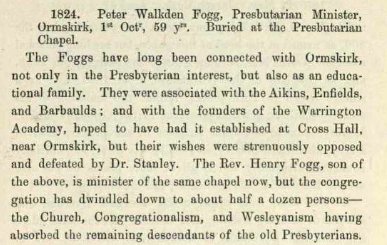
James Mawdsley married Catherine Fogg (1796-1868) from Stockport on 22nd June 1819 at St. Anne’s Church, Liverpool. Catherine was the daughter of Jane Wood and Reverend Peter Walkden Fogg (1765-1824) who was a Presbyterian minister at the chapel in Aughton Street, Ormskirk – also known as Fogg’s Chapel. The chapel was founded in 1662 and closed in 1886 after the death of Reverend Henry Fogg, Catherine’s brother who had followed in their father’s footsteps. More information can be found about Reverend Henry Fogg on FamilySearch.
Catherine and James Mawdsley had 7 children:- Jane, Eliza, Walkden,Kate, James, William and Sarah. James senior passed away on 22nd December 1844 and was buried at Halsall – right outside the window of the old Halsall Grammar School in fact. His widow, Catherine moved to Barton and in the 1851 Census for Downholland, we can see that she too was a teacher and her daughter, Eliza was an assistant teacher. According to the probate records in relation to Catherine, she had moved to Ormskirk, her death occurring in Scarisbrick on 20th July 1868. She was buried with her husband and son, William at Halsall Church.
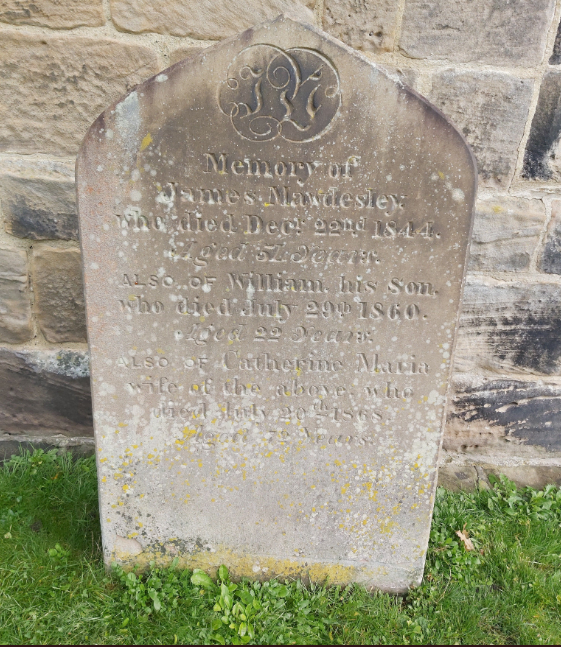
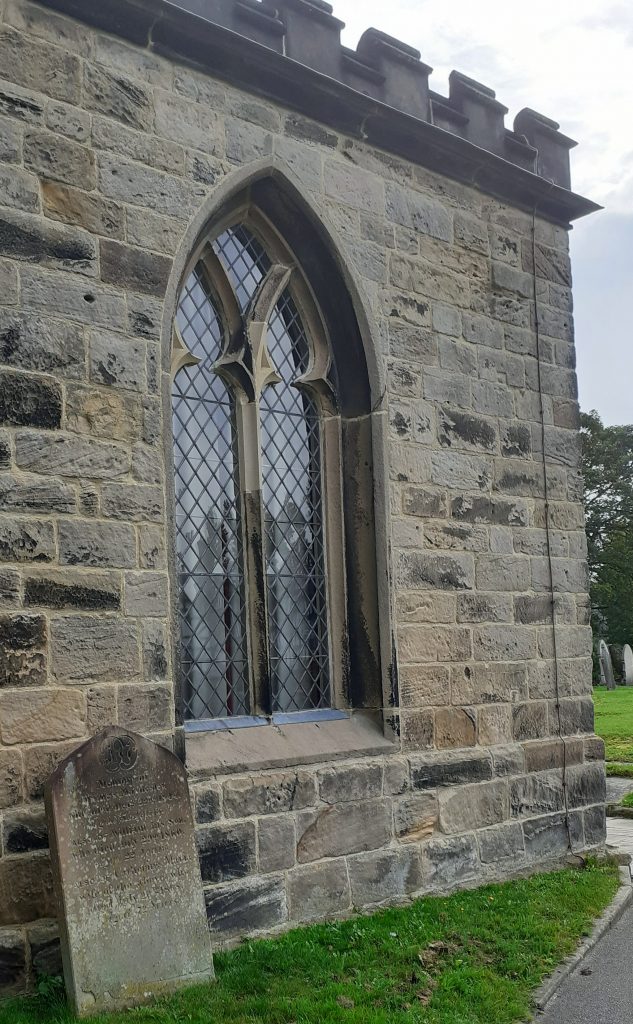
Their oldest son, Walkden (1825-1875) emigrated to Canada soon after his father’s death. In 1847 he married Effie Wormer and they had 9 children together. Like his parents, Walkden became a school teacher (and was also a member of the Volunteer Militia). Sadly, he died on 6th August 1875 in Welland, Ontario, Canada. The cause of death was recorded as drowning.
So from 1861 until the end of 1906, Halsall School was located on Summerwood Lane. The school was also home to the Halsall Temperance Society, the secretary of which was John Wilson, the local sadler from Bangor’s Green Lane. Looking back in the Ormskirk Advertiser, many evenings of entertainment were held here including the Christy Minstrels and the illusionist and ventriloquist, ‘The Great Walter Roselle’!

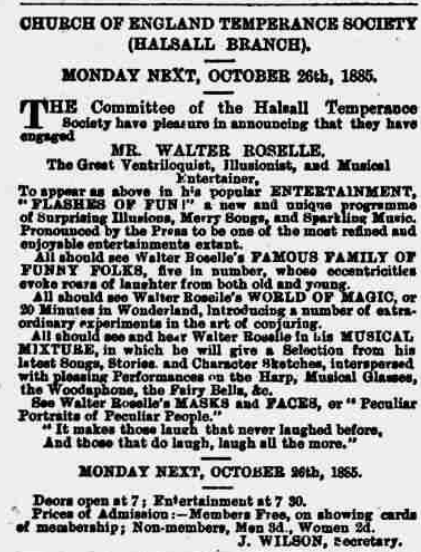
The schoolmaster at this time was Mr. William Jones , born in 1834 in Aldford, Cheshire to Hannah and John Jones, a farmer. William came to Halsall in 1854 to teach at the Grammar School initially. He married a local girl, Ellen Knowles on 16th March 1858 at St. Cuthbert’s Church. Ellen was the daughter of Mary Howard and Richard Knowles , a miller on New Street. As well as his other duties as Head Teacher, Mr. Jones kept a school log book, the contents of which are interesting in more ways than one.
[All Halsall School Reports by Kind Permission of St Cuthbert and Halsall Community Hub Archives ]
Tuesday 19th January 1864
The Haskayne boys absent today. They are gone to a tea party at Lydiate.
Friday 22nd January 1864
Tried the 1st class in the 4th Standard. They did their arithmetic correctly on slates but not so well on paper.
Friday 5th February 1864
Several boys cautioned about their slovenly appearance.
Thursday 11th February 1864
James Haslam , one of the scholars killed today by a cartwheel running over him.
Monday 22nd February 1864
Cold day. Richard Edwards playing truant on the Dam this afternoon.
Tuesday 23rd February 1864
Charged Richard Edwards with his crime which he denied. Made inquiries at home and found him guilty of his crime, to which he had added by lying. He was punished accordingly.
Monday 4th April 1864
The fine weather has taken many boys away to help in the fields.
Thursday 7th April 1864
Samuel Park punished for coming to school with dirty shoes.
William and Ellen Jones and their four children lived in the schoolhouse on Summerwood Lane. However, in 1888, Ellen passed away and was buried on 19th May of that year at St. Cuthbert’s church. After her death, Mr. William Jones returned to school on 1st June 1888. It appears he had a lot to cope with not only in his home life but in his professional life too.
3rd February 1888
There are several stupid, obtuse boys in Stand: IV who will require vast teaching to make them pass. Ralph Melling is hopeless.
27th April 1888
The boys from the infant school were admitted this week. The specimen is somewhat better than last year. Still their attainments are poor.
1st June 1888
With the exception of two boys, the whole of the boys in Stand: V are dullards. They are bad in everything and it will take much pains and hard work to bring them up for examination next year.
Mr. William Jones continued to head the school until November 1st, 1901 – a simple note was written in the school log book to record the event.

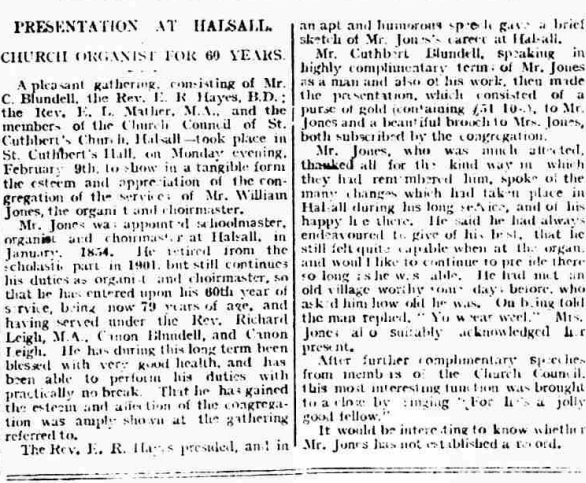
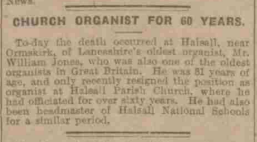
The following year, on 28th October 1902, at the age of 68, William Jones married his second wife, Miss Margaret Mary Glennie , a 42 year old spinster born in Aberdeen. Margaret had moved down to Halsall to work as a ladies maid for Ethel Hilda Blundell Hollinshead Blundell, daughter of Canon Blundell, rector of St. Cuthbert’s.
As William was also the church organist and choir master, their paths would have crossed on numerous occasions in a small village such as Halsall.
In the 1911 census we can see that William and Margaret are still living in Halsall – in Carr Moss Lane, in fact (according to the Probate record of William).
William continued to be the organist and choirmaster at Halsall until 1914, when an article was published in the Ormskirk Advertiser to celebrate his achievement as Church Organist for 69 years.
William Jones died the following year and was buried on 21st September 1915 at St. Cuthbert’s church.
Thomas Arthur Brook took over the headship of Halsall School on 4th November 1901. If we revisit the school log, it is clear to see that times were extremely hard for the families of the village. Illness, extreme weather and manual work all had an effect on the education of the children at this time as we can see from some of the following extracts:
13th January 1903
Today there are 71 children present out of 230 which is an improvement on yesterday. The whole of the absent ones have good cause for absence, being either themselves sick or living at infected houses. Whooping cough is worse than before the holidays.
2nd September 1903
An exceedingly wet day. 100 children absent out of 230.
2nd October 1903
Closed school for a week for the potato harvest.
18th January 1904
Had to send the Sephton children of Plex Lane home again as the mother wrote to say that the baby had measles and she had kept one girl at home to nurse it. This family has 4 children on the registers.
7th February 1904
2 boys were sent today with the parish nurse to the Liverpool Eye Hospital to have their eyes tested, the Rector paying the expense.
31st March 1904
Miss MacCallum ceased duties in this school. The children of her class subscribed a very handsome present for her and the number of crying children last night testified to the affection with which Miss MacCallum has been regarded.
13th April 1904
Some of the farmers are today carting manure which I am informed is slaughter-house refuse. The smell therefore is so bad that we have to keep doors and windows shut in order to keep it out as much as possible.
20th June 1904
The policeman called at school this morning about boys using catapults. I allowed him to warn a few boys who had been using them last Saturday.
8th July 1904
Ringworm is attacking several of the scholars and I cannot ascertain that the parents are properly treating it. There is 1 case of mumps.
12th July 1904
No school. Canon Blundell’s treat. All children taken to Botanic Gardens.

In 1904, Cannon Blundell , (1834-1905) the Rector of Halsall and his brother Colonel Henry Blundell Hollinshead Blundell (1831-1906) started the building of a new school on New Street.
Sadly, neither man would have seen the procession of staff and children walking from the ‘Old Schools’ of Summerwood Lane to the new school on New Street (as outlined in the school log book opposite).
Canon Blundell passed away in 1905 and Colonel Blundell died a year later in 1906.
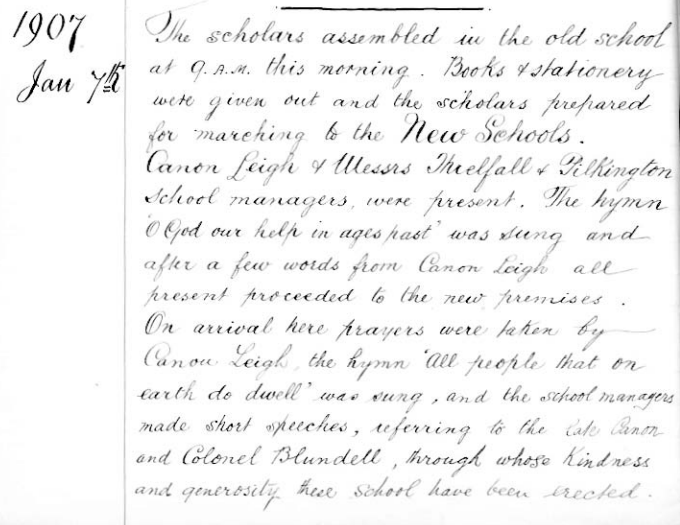
With the new school on New Street now occupied a decision needed to be made about what was to become of the ‘Old Schools’ on Summerwood Lane. It was decided that the building would be adapted for parochial purposes and, once again, the Blundell family came to the fore. Major Cuthbert Blundell (1880-1947), son of Canon Thomas Blundell Hollinshead Blundell, had many improvements and alterations made to the Old Schools. A large coke-burning stove was installed to keep its occupants warm. Although, toilets were nothing more than wooden seats and buckets, separated by corrugated iron walls and no wash basins!
On the 10th September 1907, the Church Council met in the Old Schools – present were:- Rev. Canon Leigh (Rector of Halsall), Messrs. Banks, Haslam, E. Threlfall, Neale, Sephton, Jones, Harrison and Rev. R. Whittaker. It was decided to form a management committee in respect of the newly named St. Cuthbert’s Hall so the following men (no women!) were added to the Church Council – R.G. Leigh, J. Pilkington, R. Pilkington, R. Cropper, Rhodes, Brook, Tebbut and Wilson. Cuthbert Blundell was elected President of St. Cuthbert’s Hall as it was to be known.
The following week when the Management Committee met again on 17th September, a decision was made to purchase new chairs, seats and lamps to furnish the hall. Canon Leigh also announced that he had already received £22 that could be used towards the cost of the new furniture. Eleven other members that night pledged £1 each towards the fund and an appeal was made in the Halsall Parish Magazine to the parishioners of the village to do the same.
Initially, the intention of the committee was to house the Sunday School at the Hall as well as Bible classes and other organisations such as the Mothers’ Union and the Badminton club.
On the evening of 18th November 1907, St. Cuthbert’s Hall was officially opened by way of a Ball. Mr. John Heaton, secretary of the Committee at this point, was given the credit for the decoration of the hall: ‘The hall was beautifully decorated in the most tasteful manner’. Over 130 people attended and dancing lasted until 2 am, ‘to the strains of Mr. Watt’s band’. It was also noted in the December issue of the Halsall Parish Magazine 1907, that as a result of such a successful evening, ‘a handsome balance remains towards the cost of the new floor’.
Over the years many residents enjoyed themselves in St. Cuthbert’s Hall – the scouts put on shows such as ‘Shadow Plays’; children’s parties were held here at Christmas and for the Sunday School; the snooker club met in one of the separate rooms and a library was kept in another of the rooms, run by Margaret Howard.
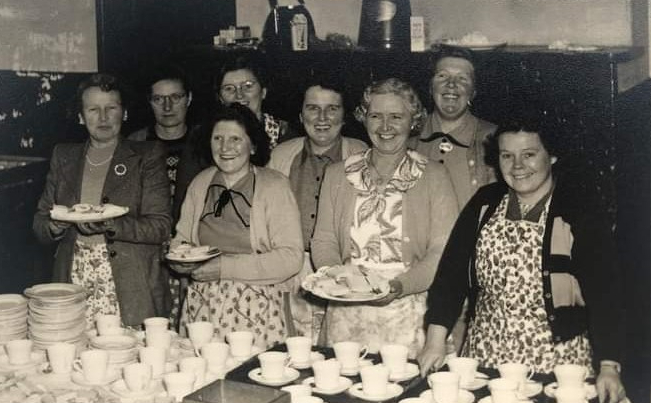
A group of ladies preparing tea for one of the many parties at St. Cuthbert’s Hall – late 1940s/early 1950s.
Back row: Mrs. Holcroft, Mrs. Gaskell, Mrs. Huyton & Mrs. Swift.
Front row: Mrs. Draper, Mrs. Halsall, Mrs. Sephton & Mrs. Heaton.
Unfortunately, by the 1950s, the future of St. Cuthbert’s Hall was looking far from promising. In the August 1953 edition of the Halsall Parish Magazine, the rector at the time, Charles Claxton (who was also the Bishop of Warrington) appealed to the residents of Halsall for help in saving the Hall. He commented on how it had deteriorated – the roof and walls needed repairing and the whole of the interior required decorating. He estimated that it would cost in the region of £2000 to fix it – approximately £46,000.00 in today’s money. He said he hoped to see the return of various organisations to the Hall such as Badminton, Drama group and the Youth Club. He also mentioned the fact that the church was prepared to purchase the building for the benefit of the village but public subscriptions would also be necessary to complete the repair work. Previously, patrons such as Major Cuthbert Blundell had paid for the maintenance of the building but this had now come to an end and such charity should not be relied upon.
Despite this heartfelt appeal, St. Cuthbert’s Hall was not saved. At one time, it even housed the hens from Oswald’s dairy farm next door!
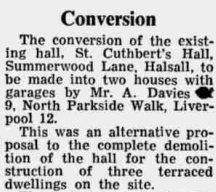
Two planning applications were made – one to demolish the building and build 3 terraced houses and another to convert the Hall into two residential properties. As we all know, the former application was passed and St. Cuthbert’s Hall was demolished – gone forever……..